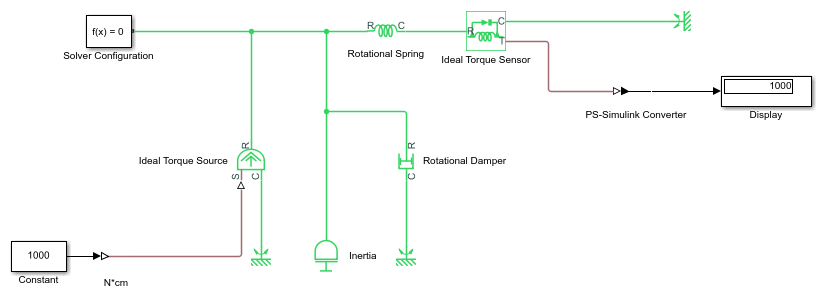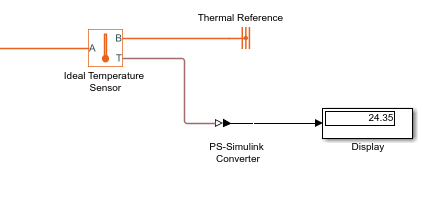PS-Simulink Converter
将物理信号转换为 Simulink 输出信号
库:
Simscape /
Utilities
描述
PS-Simulink Converter 模块将物理信号转换为 Simulink® 输出信号。使用此模块将 Simscape™ 物理网络的输出连接到 Simulink 示波器或其他 Simulink 模块。
模型画布上的模块图标显示
为了在占用最小画布空间的同时显示信号转换,此模块的图标会根据模块是否连接到其他模块而动态变化。
| 当模块…… | 模块图标 |
|---|---|
未连接时 |
|
连接到其他模块时 |
|
单位转换和检查
输出信号单位参数允许您指定输出信号所需的单位。这些单位必须与传入模块的输入物理信号的单位相称。如果指定所需的输出单位,该模块会在输出 Simulink 信号之前应用等于转换因子的增益。例如,如果传入到模块中的输入物理信号是以米为单位的位移,但您将输出信号单位设置为 mm,则模块会首先将输入信号的值乘以 1e3,然后再输出它。如果输出信号单位与输入信号单位相同,则不应用增益。
输出信号单位参数的默认值继承会根据单位传播规则自动设置模块输出端口处的单位,以匹配传入模块的输入物理信号的单位。这样,您就可以轻松将 PS-Simulink Converter 模块连接到任意信号,而无需担心设置相称的输出单位。
在下图中,PS-Simulink Converter 模块的输入信号是以 N*m 为单位的扭矩,如果不指定输出信号单位,Display 模块则将显示值 10。如果将 PS-Simulink Converter 模块中的输出信号单位参数值更改为 N*cm,Display 模块中的扭矩值则会更改为 1000,如下图所示。

当输出信号与热力学变量相关且包含温度单位时,您必须决定是否需要应用仿射转换。有关详细信息,请参阅When to Apply Affine Conversion。通常,如果输出信号表示相对温度,即温度的变化,则您需要应用线性转换 ΔTnew = L * ΔTold(默认方法)。但是,如果输出信号表示绝对温度,则您需要应用仿射转换 Tnew = L * Told + O。
在下图中,Display 模块显示了室温。如果要以摄氏度显示,请打开 PS-Simulink Converter 模块,在输出信号单位字段中键入 degC,然后选择应用仿射转换复选框。显示读数为 24.35。但是,如果清除选中应用仿射转换复选框,Display 模块则会显示 297.5。

注意
使用输出信号单位参数为输出信号指定的单位不会传播到物理网络之外。但是,如果您还指定物理单位作为连接到模块输出端口的 Simulink 信号的属性,则软件会检查这两个单位是否匹配。有关详细信息,请参阅Working with Simulink Units。


